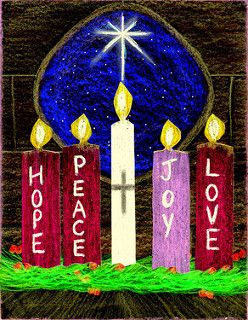
Last updated: September 29, 2024
The word Advent comes from the Latin word adventus, which means “arrival” and is also related to the words ad venire, that translate as “to come.” Since Advent has a number of moving parts, it is good for us, as pilgrims, to ask each year, “How do we Advent?” One answer of “how” relates to our journey in this season of waiting, where paradoxically we move and grow, but at the same time are called to sit waiting in stillness. Every year, we re-read the ancient prophesies, celebrate the joy of now, and look forward in hope for the light, love, and peace of the coming of Christ.
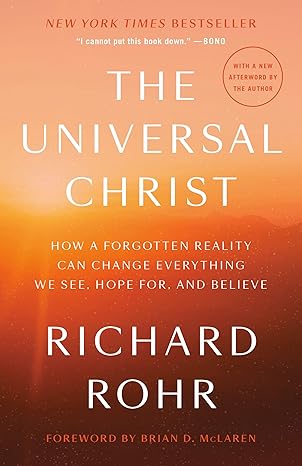
We can use this season to prepare ourselves for the birth of Jesus and at the same time build our relationship with the Universal Christ. Advent is more than a sentimental waiting for the baby Jesus to be born, but rather it gives us an opportunity to explore what Richard Rohr calls an incarnational worldview. In his book, The Universal Christ, Rohr made a statement that has fundamentally altered the way I think about Incarnation. Basically, he says that Incarnation does not mean, at face value, that God came down from heaven into the world as a baby, but rather that Jesus came out of an already Christ-soaked world. This incarnational overview is the profound recognition that matter and Spirit are not separate and that the cosmic and personal are two sides of the same reality.
We can also see Advent as a liminal time. Susan Palo Cherwien writes, “The time of Advent is a threshold, a gateway, a bridge. We are crossing over the threshold into a new year of grace. We are passing through the gate into a new circling into the transforming life of Christ. We are traversing the bridge into a new and deeper becoming, into a holy future now.”
So, as we stand at this Advent threshold location, we are encouraged to be still, and this stillness invites us to fully trust the promise that God accompanies us and is our Rock in times of difficulty.
The season of Advent is an ideal time to commit to a simple spiritual practice, as we wait and prepare for the celebration of Christmas. One way to do that is to use an Advent wreath as a focal point for prayer that can easily be accommodated before or after grace at dinner or before going to sleep at night, which is my preferred time. During Advent, I always like to turn off all the lights, except for those on my Christmas tree and the candlelight of my Advent wreath. This whole candle-lit experience doesn’t take long and is definitely worth the effort!
This blog post gives information on the history and symbolism of the Advent wreath. In addition, it describes how to buy or make an Advent wreath and shares suggestions on how to incorporate it into an Advent spiritual practice.
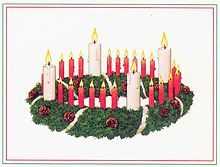
History of the Advent Wreath
The origin of the Advent wreath can be traced back to 16th century Luthern communities in Germany. However, the modern advent wreath was not really developed until the 19th century. It is believed that Johann Hinrich Wichern (1808–1881), a Lutheran pastor in Hamburg, Germany and a pioneer in urban mission work among the poor, initiated the ritual for his community.
In 1839, Wichern took a large wooden ring cartwheel and added 24 small red and 4 large white candles, similar to the graphic at the right. To help the children mark the time until Christmas, small red candles were lit successively every weekday and Saturday during Advent. Then, on each of the four Sundays of Advent, suscessive larger white candles were lit.
The Advent wreath became common in Protestant churches in Germany and eventually evolved into the smaller wreath now used worldwide. German Catholics began to adopt the custom in the 1920s, but Advent wreaths did not really become established in North America until the 1930s.
Advent Wreath Symbolism
Daniel Kantor writes, “Ritual symbols are not merely designations. Rather, they are vessels that contain storied wisdom and the echoes of history.” For this reason, it is helpful to understand the symbolism of the elements (vessels) that make up the Advent wreath. If you aren’t familiar with an Advent wreath, the most common contemporary version consists of a circular evergreen wreath, three purple or blue candles, one pink or rose-colored candle, and a white candle for the center, as shown in the image at left. There are variations, such as the German tradition of using 4 red candles, and sometimes pine cones, ribbons, or bows are added to the wreath. Reference 9 shows examples of several other Advent wreath variations.
The circlular green wreath symbolizes the never-waning nature of God’s forever love for us and the continuity of life, with no beginning or end. The steady evergreen branches also signify victory over persecution and suffering.
The color purple is the primary liturgical color for the season of Advent and is associated with the purple candles for the first, second, and fourth Sundays of Advent. Traditionally, purple during Advent symbolizes the royalty/sovereignty of Christ, the coming King. It is also the color of penitence and fasting, tools that can be used to prepare one’s heart for the coming Christ. Because of this meaning, some churches use the color blue, instead of purple, to distinguish Advent from the more penitential season of Lent, where the emphasis of purple is solemn penance. Blue is also a royal color and represents the night sky through which the Star of Bethlehem traveled. Furthermore, blue is often associated with the waters of creation and with the Virgin Mary, who was portayed in much Western art covered in a blue mantle.
The pink candle marks the third Sunday of Advent, also called Gaudete Sunday. This candle represents joy-in-hope, since gaudete is the Latin word for “rejoice” or “joyful.” Pink (or rose) is the liturgical color indicating joy, during the third week of Advent. Pink also exemplifies the rosy fingers of the dawn and the beginning of the transition from darkness to light that physically turns at the Winter Solstice on December 21. It is a hopeful forshadowing of the coming Christmas celebration.
The center white candle is called the Christ candle – the final candle that is lit on Christmas Eve or Christmas Day, when we celebrate the birth of Jesus. Visually, white is not an actual color. Rather, in the visual spectrum, white light is the combination of all the colors of the rainbow. Symbolically, it is the fresh piece of paper or canvas, pure emptiness and space, waiting to be filled. In addition, white commonly represents purity, virginity, innocence, light, and holiness. Incarnation is the white beginning point from which Jesus comes out of our already Christ-soaked world.
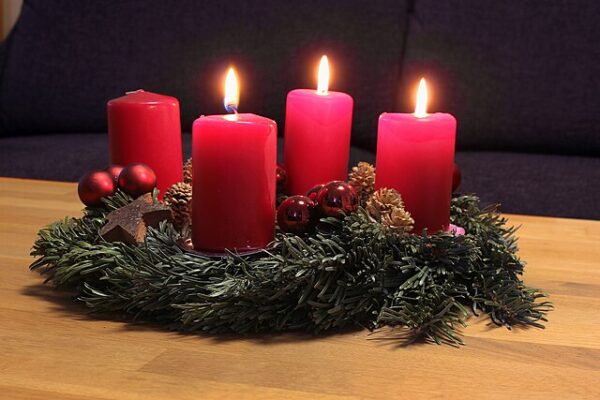
How to Buy or Make an Advent Wreath
Honestly, the easiest thing to do is to buy your Advent wreath. A simple Amazon search turns up different vendors who sell Advent wreaths, or you can find a pretty good selection at Catholic Supply of St. Louis or at The Catholic Company. You can also find advent wreaths on Etsy. Some Advent wreaths can be pretty pricey, though, so if you are even remotely crafty, it’s super easy to make your own. The first thing to do is to decide what type of candles to use. You can use pillar, taper, or votive candles.
Pillar candles last longer (but are more expensive) than taper or votive candles and, especially if you are using your wreath every day during Advent, pillar candles may be the best option. To make a simple Advent wreath with pillar candles, buy blue/purple, pink, and white pillar candles and group them together on a flat surface. If you will need to move the wreath, you can arrange the candles on a tray. Then you just cut some artificial garland to size and make a simple circle/loop that fits around the pillar candles and join the ends using hot glue or florist wire. Then you can add any ribbons or other decorations you want. Shear ribbon makes really elegant bows that you can attach to the garland.
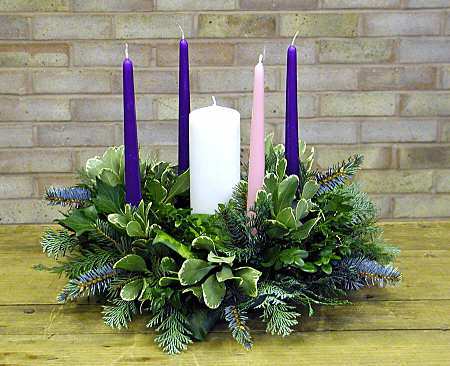
Perhaps the easiest way to construct the wreath using taper candles is to buy a styrofoam ring at a craft or art supply store, dig out holes for the candles, and then cover the ring with an artificial evergreen garland, securing it with hot glue, florist pins, or florist wire. Then just put the taper candles in the holes, securing them with putty if necessary, and your advent wreath is good to go. If you want, you can add pine cones, ribbons, or other decorations. For step-by-step instructions to make a simple styrofoam wreath or a more sturdy wooden candle holder, see reference 7. If you want to include a Christ candle, you can buy a white pillar candle or a white taper with a short candlestick holder and put it in the center. See photograph at left. If you are only using your Advent wreath briefly on Sundays, the candles should last the whole season. Otherwise, don’t forget to buy extra tapers – that first candle always burns down more than the others.
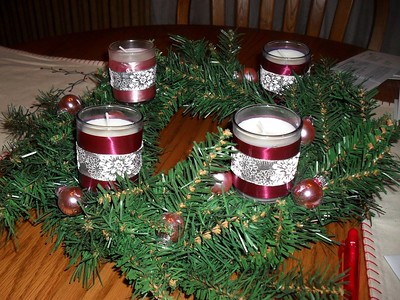
Making an Advent wreath with votive candles is also pretty simple. You can get inexpensive, clear votive holders and then paint them with purple, pink, and white acrylic paint (see reference 8.) Using this method, you can use tea light candles instead of votives for an easy-to-clean up, less expensive option. Another alternative is to adhere colored ribbon and/or craft paper to the votive holders with a glue stick, similar to the Advent wreath shown below and to the right. Or you can buy colored votive candles that you can see through the clear votive holders. Add some greenery, and you are done.
One important consideration in making an Advent wreath is to make sure that the candle flames are sufficiently separated from the evergreen wreath. In any of these variations, you can use fresh evergreen cuttings instead of artificial, but I’m always afraid of fires. Even with artificial wreaths, be certain that you keep the flames away from the greenery. Always be careful and attentive to your candles!
Using Your Advent Wreath as Spiritual Practice
There are various ways to use your Advent wreath as a spiritual practice. Generally, this means that you select a time that works for you to set aside for prayer, at least once a week on the Sundays of Advent. But not to worry – praying with your Advent wreath does not need to take very much time. Remember: even if you are completely out of balance and rushing around getting ready for Christmas, you can stop to light the candles and say a prayer before or after a common meal or before bedtime.
You can consider praying weekly on each Sunday when you light the specified Advent wreath candles or you can establish a daily spiritual practice. Below are some prayers you can use to bless your Advent wreath and to establish a simple weekly Advent wreath practice. I’ve included photos of my own Advent wreath to show the progression – I love its spiral nature. I also like to put the empty manger from my nativity set next to my Advent wreath – a visual cue related to waiting. You can use the prayers below or write your own prayers. Don’t be afraid to write your own prayers – it’s an especially intimate thing to be intentional in your prayer practice, using your own words.
Or if you already have an established spiritual practice for daily meditation, you might just want to light the candles and contemplate how your being is intertwined with waiting for the Christmas story or how you experience the Incarnation in your daily life. If you are familiar with lectio divina, you can use the Bible readings below or the texts from the O Antiphons. Lectio divina is a monastic practice for reading a text four times slowly and moving from reading for understanding to making a personal connection with the text, and then moving into meditation and contemplation.

I always look forward to lighting the candles each night and praying the O Antiphons with my Advent wreath during the last week of Advent. The word antiphon refers to a short responsive phrase that is recited or sung before and after a psalm or other prayer in a liturgy. In many monasteries, beginning on December 17, each night a different O Antiphon is chanted before and after the Magnificat (Song of Mary in Luke 1:46-55,) during Vespers (the evening prayer of the Liturgy of the Hours.) You can find more background information about the O Antiphons in my 2019 blog post here. It includes links to where you can hear them chanted in the original Latin. Also, last year I wrote blog posts for each of the O Antiphons and you can find them here: O Sapientia, O Adonai, O Radix Jesse, O Clavis David, O Oriens, O Rex Gentium, O Emmanuel, and O Virgo Virginum.
I know I’ve said it already, but just a final, gentle reminder that lighting the candles and praying with your Advent wreath in darkness is magical! A blessed Advent to all!
Blessing of the Advent Wreath
Reader: O Giver of Divine Blessing, You are sending into the world the One who shines as a light in darkness and who also waits for us in the stillness of our souls. We ask You to pour out Your blessing on this Advent wreath, through the power and energy of your Light and Love. May each candle that we light in the coming weeks, kindle within our deepest selves a desire to prepare the way for Emmanuel, God is with us. May the flames of this Advent wreath continue to grow brighter in the days to come, as we wait in joyful hope for the Incarnation. May this wreath and its light be a sign of Your promise to send Your Son. May He come quickly and without delay. Amen.
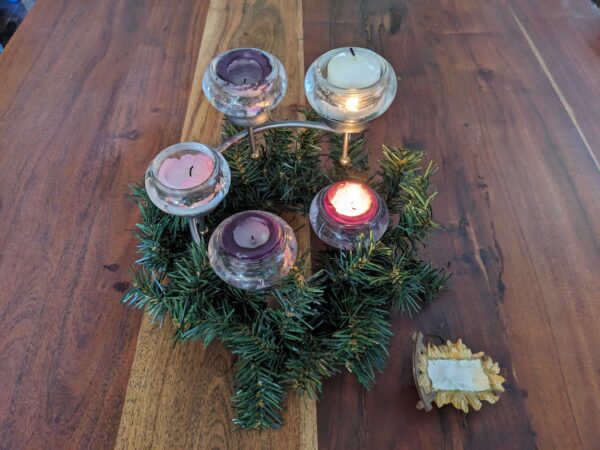
First Sunday of Advent
Reader 1: The people walking in darkness are seeing a brilliant light – upon those who dwell in a land of deep shadows, light is shining! (Isaiah 9:2)
Reader 2: Send forth your light and your truth – let them guide me, let them bring me to your holy mountain to your dwelling place. Then at last I will go up again to the altar of God, the God of my joy and delight. My harp and lyre will sing your praise once again, O God, my God. (Psalm 43:3-4)
Reader 1: Our help is in the name of the Lord. All: Who made heaven and earth.
Reader 2: In this first week of Advent, we light the first purple candle and remember the Hope that we have in Christ. Let us pray for God’s blessings upon us in this time of waiting.
All: Send Your illuminating energy into the dark shadows of our lives and keep us awake and alert for the coming of the Incarnation. Give us Your Hope, with strength enough for the journey, for we are a pilgrim people. God, let Your blessing be upon us in this Advent season.
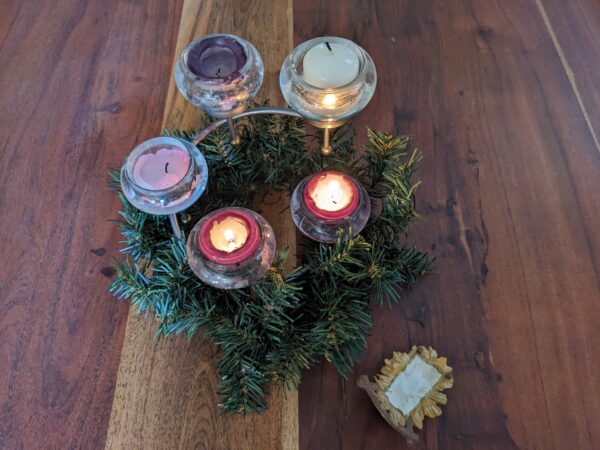
Second Sunday of Advent
Reader 1: If you give yourself to the hungry and satisfy the needs of the afflicted, then your light will rise in the darkness, and your shadows will become like noon. Yahweh will always guide you, giving relief in desert places. (Isaiah 58:10-11)
Reader 2: So many are asking, “Does good even exist anymore?” Let the light of your face, Adonai, shine on us! You put joy in my heart – a joy greater than being full of bread and new wine. In peace I will lie down, in peace I will sleep: for you alone, Adonai keep me perfectly safe. (Psalm 4:6-8)
Reader 1: Our help is in the name of the Lord. All: Who made heaven and earth.
Reader 2: In this second week of Advent, we light the first two purple candles and pray for the gift of Peace that we receive from Christ. Let us pray for God’s blessings upon us in this time of waiting.
All: Help us to be open and honest with ourselves, as we walk toward You on this Advent path. Let Your face shine upon us, and make ready our hearts for the coming of Christ. Send us Your patient energy as You continue to prepare us for the coming days. God let Your blessing be upon us in this Advent season.
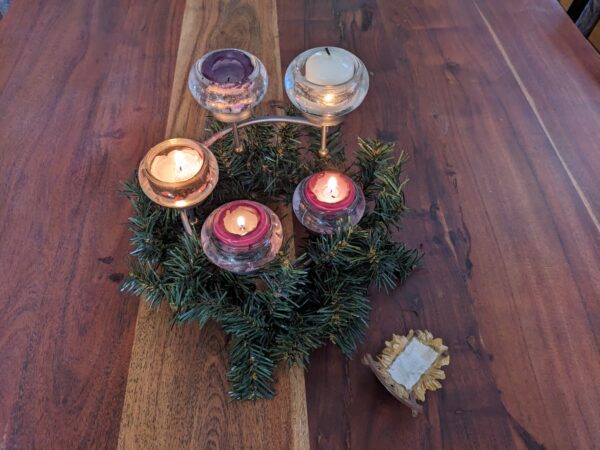
Third Sunday of Advent
Reader 1: Arise, shine, for your light has come! The glory of Yahweh is rising upon you. Though darkness still covers the earth and dense clouds enshroud the nations, upon you, Yahweh now dawns and God’s glory will be seen among you. The nations will come to your light and the leaders to your bright dawn. (Isaiah 60:1-3)
Reader 2: Light dawns on the just, and joy for the upright in heart. Rejoice in Our God, you just, and give praise to God’s Holy Name! (Psalm 97:11-12)
Reader 1: Our help is in the name of the Lord. All: Who made heaven and earth.
Reader 2: In this third week of advent, we light two purple candles and the one pink candle and celebrate in thanksgiving the Joy that Christ brings. Let us pray for God’s blessings upon us in this time of waiting.
All: Silence. Stir up our hearts with Your power and love, and bring us the blessing of silence and stillness, during these busy days. Send us Your quiet voice to encourage and strengthen our hearts as we wait. God let Your blessing be upon us in this Advent season.
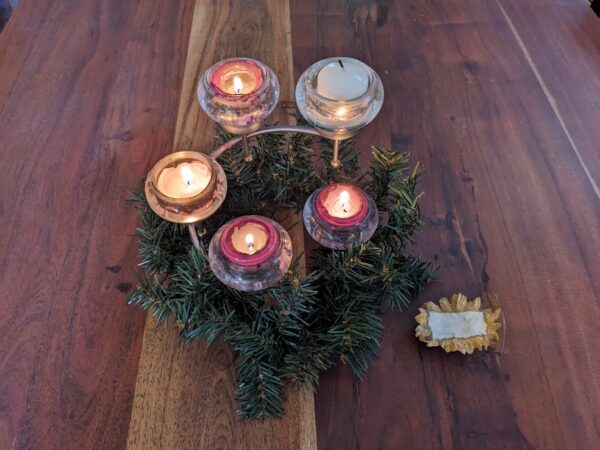
Fourth Sunday of Advent
Reader 1: I have bound myself with vows to you, O God, and will redeem them with thanks-offerings; for you have rescued me from death and kept my feet from stumbling, to walk in your presence in the light of life. (Psalm 56:12-13)
Reader 2: The next time Jesus spoke to them, he said, “I am the light of the world Whoever follows me will not walk in darkness, but will have the light of life.” (John 8:12)
Reader 1: Our help is in the name of the Lord. All: Who made heaven and earth.
Reader 2: In this fourth week of Advent, we light three purple candles and the one pink candle and pray for the Love that sustains us. Let us pray for God’s blessings upon us in this time of waiting.
All: Send us Your kind messages of love and forgiveness, for we know that You always meet us in our times of deep difficulties and sorrow. Come quickly and surprise us with Your Loving Kindness. God let Your blessing be upon us in these late days of the Advent season.

Christmas Eve or Christmas Day
Reader 1: Adonai, you are my light, my salvation – whom will I fear? You are the fortress of my life – of whom will I be afraid? One thing I ask of you, one thing I seek: that I may dwell in your house all the days of my life, to gaze on your beauty and to meditate in your temple. (Psalm 27:1, 4)
Reader 2: In the beginning there was the Word and the Word was in the presence of God, and the Word was God. The Word was present to God from the beginning. Through the Word, all things came into being and apart from the Word, nothing came into being that has come into being. In the Word was life, and that life was humanity’s light – Light that shines in the darkness, a Light that the darkness has never overtaken. (John 1:1-5)
Reader 1: Our help is in the name of the Lord. All: Who made heaven and earth.
Reader 2: On this Christmas Eve/Day, we light all of the Advent candles, including the white Christ candle and rejoice that Emmanuel, God is With Us. Let us pray for God’s blessings upon us in this time of promises fulfilled.
All: On this day we celebrate the conclusion of our Advent waiting. O Emmanuel, God is among us! Divine Light, let your blessing and Word be upon us as we celebrate the Incarnation, the coming of Jesus out of an already Christ-soaked world. We rest in the great love You have for us and the entire universe!
UPDATE: This blog post was updated on September 29, 2024 to include two additional images, to check all hyperlinks, and to make minor editoral changes.
Readings: The Inclusive Hebrew Scriptures, Volumes II and III, Priests for Equality, Brentwood, MD, 1999 and The Inclusive New Testament, Priests for Equality, Brentwood, MD, 1994.
Reference 1: Susan Palo Cherwien, “Advent is a Threshold,” blog post at Night of Silence website, https://www.nightofsilence.com/blog/2017/4/13/threshold, April 13, 2017.
Reference 2: Daniel Kantor, “The History of the Advent Wreath,” blog post at Night of Silence website, https://www.nightofsilence.com/blog/2018/11/28/advent-wreath, November 28, 2018.
Reference 3: Richard Rohr, The Universal Christ: How a Forgotten Reality Can Change Everything We See, Hope for, and Believe, (New York: Convergent Books, 2019.)
Reference 4: Discipleship Ministries, The United Methodist Church, “The Color Blue in Advent,” https://www.umcdiscipleship.org/resources/the-color-blue-in-advent, May 2007.
Reference 5: Daniel Kantor, “The Colors of Advent,” blog post at Night of Silence website, https://www.nightofsilence.com/blog/2018/10/29/the-colors-of-advent, October 10, 2018.
Reference 6: Robyn Huff, “Easy Ideas for a Simple DIY Advent Wreath for Christmas,” blog post at Robyn’s French Nest.
Reference 7: Phil B, “Making an Advent Wreath for Your Family,” blog post at Instructables website, CC-BY-NC-SA, 2012.
Reference 8: Ann Marie, “Painted Votive Advent Wreath,” blog post at White House Black Shutters website, November 30, 2012.
Reference 9: Shawn Tribe, “Variations in Form of the Advent Wreath,” Liturgical Arts Journal, November 20, 2019.
Image 1: Christ Candle 2015, John Stuart, stushieart.com, traqair57, flickr.com, October 11, 2015, used with permission.
Image 2: The Universal Christ, book design by Andrea Lau.
Image 3: Early concept of Advent wreath developed by Johann Hinrich Wichern, https://en.wikipedia.org/wiki/Advent_wreath.
Image 4: Advent Wreath with Blue Candles, Wikimedia Commons, CC BY-SA 3.0, https://en.wikipedia.org/wiki/Advent_wreath#/media/File:Adventwreath.jpg, December 25, 2012.
Image 5: Advent-Adventskranz, Wikimedia Commons, CC BY-SA 3.0, https://commons.wikimedia.org/wiki/File:3._Advent_-_Adventskranz_(2022-12-12_Sp).JPG, December 12, 2022.
Image 6: Advent Wreath, Margaret Dvorak, https://campaign.r20.constantcontact.com/render?m=1118893490133&ca=fdb367b7-91c8-4dc7-8599-70c0dec6b356, 2016.
Image 7: Advent Wreath, Annie Pilon, flickr.com, CC BY 2.0 DEED, July 4, 2009.
Image 8: A Liturgical Advent Banner, Lois Prahow, posted to Christian Clip Art Review, March 6, 2017.
Image 9: Advent Wreath – Week 1, Julie Henkener, 2023.
Image 10: Advent Wreath – Week 2, Julie Henkener, 2023.
Image 11: Advent Wreath – Week 3, Julie Henkener, 2023.
Image 12: Advent Wreath – Week 4, Julie Henkener, 2023.
Image 13: Advent Wreath – Christmas, Julie Henkener, 2023.
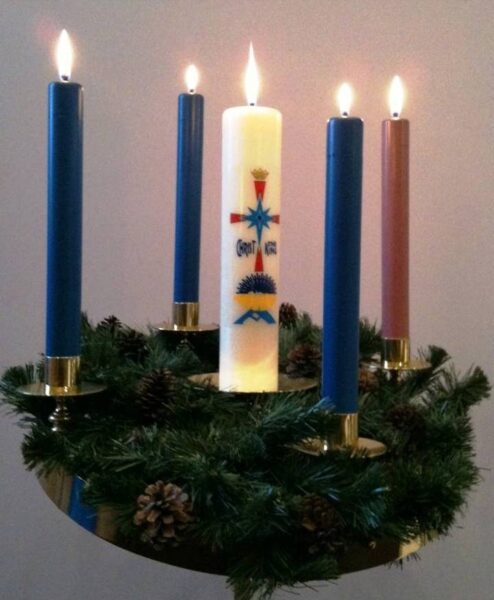















2 Comments
Leave your reply.